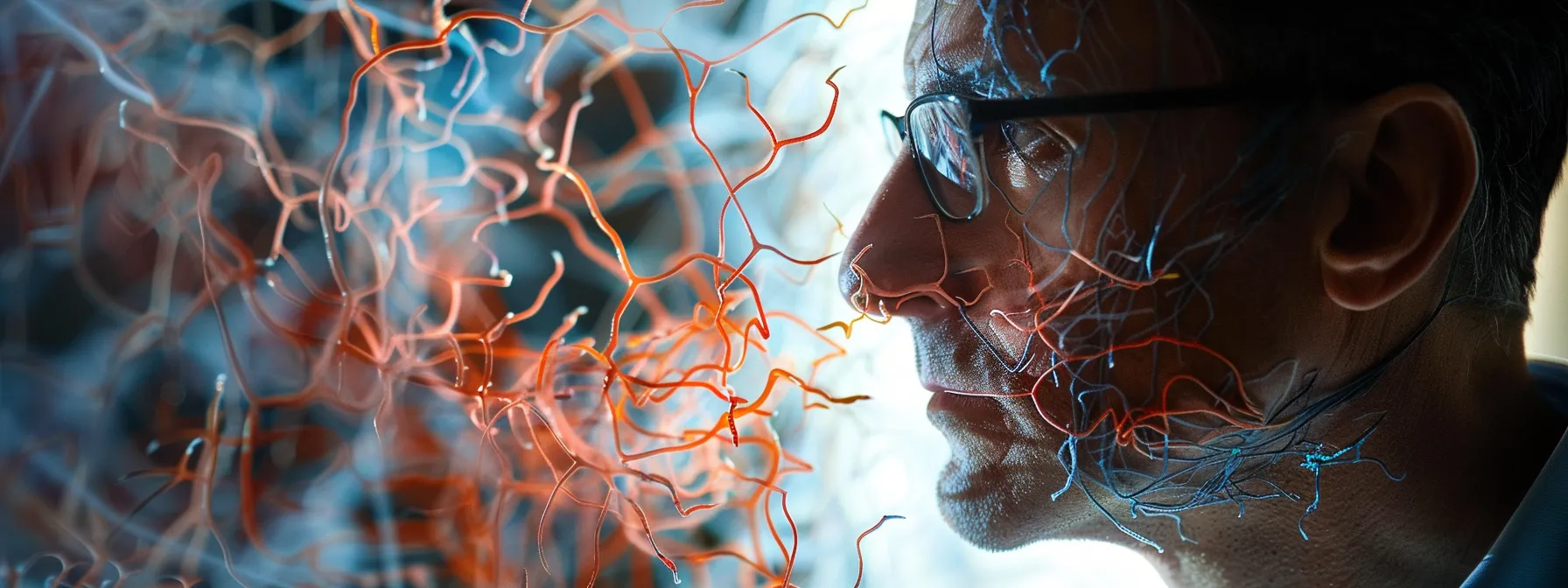Understanding Bipolar Disorder: Insights Into the Mindset From Experts

Table Of Contents:
- Understanding Bipolar Disorder: Insights Into the Mindset From Experts
- Key Takeaways
- Introduction to Bipolar Disorder
- Understanding the Basics of Bipolar Disorder
- Differentiating Between Bipolar I and Bipolar II
- The Impact of Bipolar Disorder on Daily Life
- The Mindset of Someone Living With Bipolar Disorder
- Exploring Emotional Highs and Lows
- How Thought Patterns Change During Episodes
- Coping With Internal Conflicts and Self-Perception
- Expert Insights on Bipolar Thought Processes
- Common Misconceptions Addressed by Psychiatrists
- Psychological Factors Influencing Bipolar Thinking
- Strategies Experts Recommend for Managing Thoughts
- Recognizing Early Signs and Symptoms
- Behavioral Indicators to Watch For
- The Importance of Early Detection
- How to Approach a Loved One Showing Symptoms
- The Role of Therapy in Understanding Mindset
- Cognitive Behavioral Techniques for Bipolar Disorder
- Benefits of Psychotherapy Sessions
- Success Stories: Overcoming Challenges Through Therapy
- Medication and Its Influence on Thought Patterns
- How Mood Stabilizers Affect the Brain
- Managing Side Effects While Maintaining Clarity
- Collaborating With Healthcare Providers for Optimal Results
- Conclusion
Have you ever wondered what goes on in the mind of someone with bipolar disorder? This chronic condition affects millions, yet misunderstandings persist. Our article delves into the mindset of those living with the disorder, offering insights from experts.
We will explore the early signs and symptoms to watch for, and discuss how therapy and medication play crucial roles in managing the disease. By engaging, you’ll gain a deeper comprehension of bipolar disorder, equipping you with the knowledge to support mental health in yourself or others. This understanding can be empowering, providing a foundation for open conversation and reducing the stigma this health issue often carries. For further information, consider visiting Mind UK’s bipolar disorder page.
Key Takeaways
- Bipolar disorder involves extreme mood shifts affecting daily life and relationships
- Early detection and tailored treatments significantly improve bipolar disorder management
- Psychotherapy and lifestyle adjustments play crucial roles in stabilizing bipolar symptoms
- Strong support systems and clear communication with loved ones are central to effective management
- Education and combating stigma are essential for empowering individuals with bipolar disorder
Introduction to Bipolar Disorder

Bipolar disorder, a complex mental disorder, often manifests through extreme mood swings that include emotional highs, known as mania, and lows, or depressive episodes. In my exploration of this condition, I’ll first clarify its basics, delineating the differences between Bipolar I and Bipolar II, and illustrating their distinct features. The impacts this disorder has on everyday life, including sleep patterns, workplace challenges, and susceptibility to substance abuse, will also be discussed. With a focus on psychotherapy and other treatments, I aim to provide valuable insights into managing this condition effectively. Bipolar disorders
Understanding the Basics of Bipolar Disorder
In my experience, grasping the basics of bipolar disorder is pivotal for those living with the condition and their loved ones. It’s characterized not just by the expected mood swings, but in severe cases, it can also involve psychosis, where one loses touch with reality. Differentiating bipolar disorder from major depressive disorder is critical because the treatment and impact on one’s life vary significantly between the two.
One aspect I’ve seen people struggle with is recognizing when typical mood fluctuations cross into the territory of bipolar disorder. It’s more than just feeling up or down; it’s about extreme changes in energy, activity, and sleep patterns that can severely disrupt daily life. This understanding is a cornerstone of managing the condition, guiding individuals towards treatments that can stabilize their mood swings and provide relief from the intense episodes of depression and mania. Understanding bipolar disorder in depth is crucial for those affected and their support networks.
Differentiating Between Bipolar I and Bipolar II
Understanding the nuances between Bipolar I and Bipolar II is critical for proper diagnosis and treatment. Bipolar I disorder is characterized primarily by the occurrence of one or more manic episodes, with possible periods of major depressive episodes. In contrast, those with Bipolar II experience a milder form of mania, known as hypomania, which is often less disruptive, followed by one or more major depressive episodes.
While Bipolar I can be mistaken for other mood disorders due to its prominent manic phases, Bipolar II often has symptoms overlapping with conditions like major depressive disorder or attention deficit hyperactivity disorder (ADHD), complicating its identification. My professional experience highlights the importance of distinguishing these subtypes: the subtler hypomanic episodes of Bipolar II can easily be overlooked, yet understanding this can illuminate the most effective treatment paths and provide hope for those affected: Bipolar Disorder
- Manic episodes in Bipolar I lead to extreme elevations in mood and energy that impair daily functioning.
- Hypomanic episodes in Bipolar II are less intense, allowing individuals to function, albeit not at their optimal level.
- Major depressive episodes are common to both, presenting a risk of misdiagnosis if not carefully assessed against the backdrop of manic or hypomanic symptoms.
The Impact of Bipolar Disorder on Daily Life
The daily life of a person with bipolar disorder is often a relentless roller-coaster of emotions, impacting mental health significantly. Mood swings can extend from mania, reminiscent of Bipolar I, to less intense hypomanic stages associated with Bipolar II, and even cyclothymia, a milder form of the condition. These fluctuations deeply affect one’s ability to maintain steady relationships within the community and to adhere to life’s routines.
As someone with firsthand knowledge of managing bipolar disorder, I’ve seen how using mood stabilizers becomes essential for maintaining equilibrium. Still, it goes beyond medication: suicide prevention is also a critical aspect of caregiving and self-care in bipolar disorder. Here’s an outline of accountabilities for those living with bipolar disorder and their support network:
- Timely taking of prescribed mood stabilizers to manage symptoms.
- Regular engagement with mental health professionals for monitoring and adjustments in treatment plans.
- Building a support system within the community for emotional backing and understanding.
- Implementing and adhering to lifestyle changes that promote mental health stability.
- Prioritizing suicide prevention strategies, including therapy, support groups, and emergency planning.
Bipolar disorder sketches a rugged landscape in the mind, where the peaks and valleys run deep. Walk with me now into the daily reality of those who navigate this terrain, where every sunrise brings a new challenge. For more information, consider visiting NIMH on Bipolar Disorder.
The Mindset of Someone Living With Bipolar Disorder

Delving into the mindset of someone with bipolar disorder means acknowledging the risk of enduring emotional extremes and shifting thought patterns. In my exploration into this area, we’ll examine the highs and lows, understanding how individuals navigate these turbulent times. Deeper insight into behavior during these episodes, as outlined in the Diagnostic and Statistical Manual of Mental Disorders, aids in accurate diagnosis and guides antipsychotic treatment strategies in psychiatry. Additionally, we’ll consider how internal conflicts and self-perception shape the personal experience, providing context to each aspect of the bipolar mindset and enhancing our coping strategies. Delve further into understanding bipolar disorder for a deeper insight.
Exploring Emotional Highs and Lows
In my professional journey working alongside those affected by bipolar disorder, I’ve seen how the emotional highs can present misleading visages of boundless energy and creativity. These mania episodes, however, can lead to risky behaviors, such as increased alcohol consumption, which often requires intervention from a health professional. Stability is sometimes found through the administration of mood stabilizers like lithium, which, when combined with therapies such as cognitive behavioral therapy, brings balance to these overwhelming tides of emotion.
The depths of the depressive lows in bipolar disorder can be equally challenging, where the light of one’s spirit dims to a mere flicker. It’s in these troughs that the support of antidepressants and structured sessions with a cognitive behavioral therapist can be most impactful. As an expert, I advocate for a tailored approach in collaboration with health professionals to establish a regimen that not only alleviates these valleys but also fosters resilience and a path towards a more stable future.
How Thought Patterns Change During Episodes
During manic episodes, the brain‘s rapid firing can skew perception and influence harmful behaviors such as problem gambling or a heightened risk of developing a substance use disorder. I’ve observed that patients may experience decreased sensitivity to risk and an inflated sense of capability, which can intensify stress levels and further complicate their mental state. It is vital for caregivers and individuals to notice these shifts in thought patterns, as they may signal the need for interventions like medication adjustments or psychotherapy sessions to mitigate these risks.
Conversely, during depressive phases, thought patterns often become saturated with negativity and hopelessness, impacting decision-making and daily functionality. I’ve recommended electroconvulsive therapy as a last resort for treatment-resistant depression associated with bipolar disorder, which has shown efficacy in rebooting neural pathways and providing relief. Understanding these profound changes in cognition is crucial, as it allows us to tailor treatments effectively and empowers those with bipolar disorder with strategies to manage stress and navigate their condition with resilience.
Coping With Internal Conflicts and Self-Perception
Living with bipolar disorder often means grappling with internal conflicts that can erode self-perception. A profound understanding, grounded in data from the National Institute of Mental Health, underscores the significance of recognizing hallucinations and delusions as potential risk factors that can compound these struggles. For me, guiding individuals towards early intervention with a mental health professional can be key to navigating these challenges, fortifying their self-image against the distortions caused by the disorder’s fluctuating energy levels.
Embracing one’s mental health journey entails acknowledging these intrapersonal rifts and working towards healing. My experience has taught me that long-standing internal conflicts can hinder recovery if left unaddressed; thus, I advocate for the proactive involvement of mental health professionals to aid in restructuring a more positive self-perception. This approach not only mitigates the harm from altered thought patterns but also empowers patients to reclaim control over their narrative:
| Mental Health Aspect | Impact on Self-Perception | Strategy for Improvement |
|---|---|---|
| Internal Conflicts | Erosion of Self-Image | Therapeutic Interventions |
| Hallucinations/Delusions | Distortions in Reality | Early Professional Engagement |
| Energy Fluctuations | Challenges in Self-Management | Structured Support Systems |
Navigating the ebb and flow of emotions is a daily reality for those with bipolar disorder. Now, we turn our lens to the insights of experts who dissect these complex thought patterns with clarity.
Expert Insights on Bipolar Thought Processes

In my conversations with psychiatrists, we often discuss the intricacies behind the thinking patterns of patients with bipolar disorder. Common misconceptions are frequently addressed—yes, exercise can benefit one’s mental state, but it’s not a cure-all. Suicidal ideation, a grave concern, necessitates vigilance and acute management strategies. Through understanding psychological factors that influence bipolar thinking and the intersection with anxiety disorders, experts highlight tailored strategies for managing thoughts. I will delve deeper into these expert insights, aiming to clarify the complexities and offer valuable strategies for those affected.
Common Misconceptions Addressed by Psychiatrists
In my conversations with experts, there’s a pressing need to address the common misconception that bipolar disorder is akin to schizophrenia. Misinformed comparisons can cause confusion: schizophrenia is a distinct condition with its unique set of symptoms. My discussions with psychiatrists emphasize the importance of research to distinguish between the two, as conflating them affects the coping strategies and treatments patients receive, not to mention the personal impact of living with an inaccurately labeled condition.
Another aspect where clarity is crucial lies in understanding what constitutes a mixed affective state. Often, individuals believe it simply combines symptoms of mania and depression, but it’s more nuanced. Through my interaction with clinical professionals, I’ve learned that recognising the presence of delusion during these periods is vital. Without accurate identification and understanding by both patients and practitioners, the risk of mismanaging bipolar disorder escalates substantially:
- Misconception of Bipolar disorder and Schizophrenia as similar conditions.
- Lack of research-driven knowledge affecting patient coping mechanisms.
- Misunderstanding the complexity of mixed affective states.
- Underestimating the role of delusions in bipolar thought processes.
Psychological Factors Influencing Bipolar Thinking
In my consultations with mental health experts, I’ve learned that accessing accurate information about bipolar disorder is essential for understanding the psychological factors influencing bipolar thinking. Medicine, including mood stabilizers like valproate, plays a significant role in managing cognitive symptoms, yet it’s crucial for patients to understand how medication interacts with their thought processes. Solid, evidence-based information empowers individuals to make informed decisions about their treatment, especially concerning managing insomnia and other cognition-related issues.
My work with patients has underscored that knowledge, especially regarding the psychological impact of bipolar disorder, goes hand in hand with medication in improving mental health outcomes. It’s not enough to prescribe a treatment; as a caregiver, I ensure that patients comprehend the implications of their disorder on cognition and the potential benefits of therapies like valproate. This approach fosters a more robust overall well-being, equipping individuals with the insights they require to navigate the complexities of bipolar disorder effectively.
Strategies Experts Recommend for Managing Thoughts
In my discussions with psychiatrists, a consistent recommendation for managing racing thoughts, a common challenge in bipolar disorder, is to consider treatment options like transcranial magnetic stimulation (TMS). This non-invasive method, endorsed by institutions such as the Mayo Clinic, stimulates the brain using magnetic fields and has been shown to alleviate symptoms, including intrusive thoughts, without the side effects typically associated with medication.
Another therapeutic strategy that I’ve seen transformative results with is interpersonal and social rhythm therapy (IPSRT). Rooted in the understanding that disruptions in daily rhythms can trigger mood swings, IPSRT focuses on stabilizing sleep patterns and daily routines. This method, often imparted by psychiatric specialists, helps individuals create a consistent lifestyle which significantly reduces the frequency of episodes and helps manage their impact on thoughts and emotions.
Having delved into the depths of bipolar thought processes, we understand their complexity. Let’s now turn our attention to the early indicators, catching whispers before they turn into storms.
Recognizing Early Signs and Symptoms

Through my professional lens in psychology, I’ve seen the profound difference early detection can make in diagnosing and managing bipolar disorder. Behavioral indicators, such as shifts in a person’s baseline activity or spikes in alcohol abuse, are vital signs I watch for. It’s crucial to understand the importance of early detection, which often involves close observation and consultation with a physician. Addressing these concerns can be challenging, especially when approaching a loved one, but doing so with sensitivity and care is key to encouraging them to seek help. Each of these points—behavioral signs, timely diagnosis, and the delicate approach to loved ones—will be explored in depth to provide clear guidance.
Behavioral Indicators to Watch For
In my professional experience, I’ve found that early recognition of behavioral indicators is crucial for addressing bipolar disorder before it progresses. The American Psychiatric Association advises looking for significant changes in energy, activity, or sleep patterns that deviate from a person’s usual behavior. I often counsel that if these changes are accompanied by mood swings or a noticeable decline in function across various areas of life, then it might be time to seek a thorough physical examination and psychological evaluation from a mental health professional.
Having worked with organizations like the National Alliance on Mental Illness, I strongly recommend paying attention to subtler signs as well, such as a gradual withdrawal from social activities or a sudden interest in alternative medicine without previous history of such inclinations. These shifts may not always signal bipolar disorder, but they warrant further investigation by a mental health specialist to determine if these are part of a larger pattern indicative of a mood disorder. A comprehensive approach involving family history and ongoing support plays a key role in managing the complexities of mental health.
The Importance of Early Detection
From my standpoint as a mental health professional, I cannot overemphasize the importance of early detection of bipolar disorder. Acknowledging early symptoms, which might be mistaken for seasonal affective disorder or a personality disorder, can significantly influence the treatment’s efficacy. Family history and genetics play a role too, highlighting the need for a thorough evaluation, especially if bipolar ii disorder runs in the family. Access to information about these conditions has greatly improved thanks to the internet, enabling individuals to seek help sooner.
I have witnessed the transformative power of early intervention firsthand. When bipolar disorder is detected and managed early, individuals have a better chance of mitigating severe mood swings and establishing long-term stability. Early detection requires a proactive stance, educating oneself on symptoms and seeking regular evaluations if there’s a known predisposition. It’s a step that not just helps in managing the condition but also empowers individuals to maintain control over their lives.
How to Approach a Loved One Showing Symptoms
If I’ve learned anything from my experiences, it’s that approaching a loved one who may be showing symptoms of bipolar disorder requires a blend of education and empathy. When fatigue disrupts their usual lifestyle or their behavior changes inexplicably, it’s important to gently encourage them to explore treatment options that might include mood stabilizers like lamotrigine or atypical antipsychotics such as olanzapine. Conveying your support by offering to help with research or finding a healthcare provider can make a significant difference in their willingness to seek help.
In dealing with such sensitive matters, I’ve found it’s critical to balance concern with respect for the individual’s autonomy. Drawing from a position of informed support, suggest considering lifestyle adjustments or medical treatments that have proven helpful to others, without insisting on immediate action. Demonstrating understanding of their condition can alleviate any apprehension or stigma they might feel towards acknowledging the symptoms or using medications like lamotrigine and olanzapine, which are commonly prescribed in these cases.
As we chart the signals of distress, the way forward requires a map of the mind. Therapy casts light on these paths, guiding us to the roots of our thoughts and feelings.
The Role of Therapy in Understanding Mindset

In my practice, I’ve observed the profound effects of Cognitive Behavioral Techniques on managing bipolar disorder, specifically how they influence appetite and mood. These therapeutic strategies form the basis of psychotherapy sessions that benefit patients immensely. By reviewing success stories, one can see the power of overcoming bipolar disorder‘s challenges through therapy. This section will systematically review the role therapy plays, highlighting the benefits of various therapy approaches for individuals and caregivers as dietary considerations continue to emerge as an essential factor in treatment.
Cognitive Behavioral Techniques for Bipolar Disorder
In my practice, I’ve successfully integrated Cognitive Behavioral Techniques (CBT) to assist patients dealing with bipolar disorder, focusing on the interconnection between their thoughts, feelings, and behaviors. These techniques are particularly effective in addressing comorbid conditions that frequently accompany bipolar disorder, such as eating disorders or sleep disorders. By helping patients recognize and alter harmful thinking patterns that can lead to a cycle of manic euphoria followed by depressive states, these interventions are a cornerstone in bipolar disorder management. bipolar disorder
| CBT Aspect | Targeted Condition | Therapeutic Outcome |
|---|---|---|
| Thought Pattern Change | Bipolar Disorder | Enhanced Mood Stability |
| Behavioral Adjustment | Eating Disorder | Improved Eating Habits |
| Sleep Hygiene Education | Sleep Disorder | Regulated Sleep Patterns |
| Management of Euphoria/Troughs | Bipolar Mood Swings | Reduced Risky Behaviors |
From first-hand experience, I’ve found that incorporating CBT within a clinic setting significantly improves patients’ quality of life, even those with persistent symptoms of cardiovascular disease. Recognizing and addressing the psychological stressors that exacerbate bipolar disorder – such as anxiety related to health issues – is a service I provide to my patients. CBT offers practical techniques for managing distressing symptoms, ensuring comprehensive care that extends beyond the psychiatric clinic and into patients’ everyday lives, promoting better health outcomes overall.
Benefits of Psychotherapy Sessions
In my clinical experience, psychotherapy is instrumental in tempering impulsivity—a hallmark of bipolar disorder that can provoke both personal turmoil and abrupt lifestyle changes. Patients often report that psychotherapy has profoundly improved their quality of life, helping them foresee triggers that might lead to a relapse and empowering them with strategies to navigate the complexities of their emotional landscape. This form of therapy, by focusing on impulse control and emotional regulation, unwraps layers of the condition, fostering a patient’s ability to maintain long-term stability.
Additionally, I’ve noted that psychotherapy aids in addressing the frequently co-occurring somatic symptom disorder, which can burgeon from thyroid dysfunctions often found in those with bipolar disorder. The focus on mind-body connection within therapy sessions educates and equips individuals to better understand and manage somatic symptoms, decreasing their contribution to stress and potential exacerbation of bipolar symptoms. Through dedicated psychotherapy, patients gain invaluable insights into the somatic aspects of their wellbeing, leading to integrated and more effective management of their overall health.
Success Stories: Overcoming Challenges Through Therapy
Throughout my work, I have encountered patients with bipolar disorder who have faced the battle against social stigma. One such success story involves an individual grappling with this stigma while managing co-occurring diabetes, a physical ailment that introduces another layer of complexity to one’s health regimen. With the integration of therapy sessions focused on holistic management and the judicious use of atypical antipsychotic medications, this patient was able to reconcile the challenges of their dual diagnosis. Therapy enabled them to develop coping strategies that mitigated the psychological impact of living with both conditions, leading to a markedly improved quality of life.
I recall another patient who had struggled with the irregularities of their condition affecting their job performance and personal relationships. Frequent blood tests and medication adjustments were a part of their reality, further complicated by the overwhelming pressure of maintaining stability. In their therapeutic journey, we extensively explored techniques for mood management, finding that a combination of psychotherapy and atypical antipsychotic medication notably enhanced their ability to navigate daily stresses. This pragmatic approach offered them not just symptom relief but also a blueprint for thriving despite the complexities of bipolar disorder.
The mind, once veiled in mystery, yields its secrets to therapy‘s touch. Now, let’s turn to medication and see how it quietly reshapes our thought patterns.
Medication and Its Influence on Thought Patterns

As a professional dedicated to the treatment of bipolar disorder, I’ve observed the significant role mood stabilizers like quetiapine play in managing this spectrum disorder. They can profoundly impact the brain, often providing stability, yet they come with potential side effects that need careful monitoring. It’s imperative to collaborate effectively with healthcare providers in a psychiatric hospital setting or through outpatient care to balance therapeutic benefits with maintaining clarity of thought. Each of the following topics delves into these aspects, offering expertise on medication‘s influence on brain function, strategies to manage side effects, and fostering an optimal partnership with treatment providers for the best patient outcomes.
How Mood Stabilizers Affect the Brain
In my clinical practice, I have seen the positive effects mood stabilizers can have on the minds of those with bipolar disorder. These medications often include anticonvulsants, which are used to steady the rapid fluctuations in mood characteristic of the condition. Through their action on the brain‘s neurotransmitter systems, they help to alleviate the extreme shifts in energy and emotion that my patients struggle with, enabling a more balanced state that fosters consistent learning and functioning. bipolar disorder
However, as with any medication, mood stabilizers can have side effects, and one common concern for my patients has been the potential for weight gain. This is a notable issue, especially for those working towards weight loss or managing a dual diagnosis that includes a condition like diabetes. I ensure to monitor my patients closely, offering strategies to maintain a healthy weight and lifestyle, thus mitigating this side effect while they benefit from the stabilizers’ therapeutic action on their thought patterns.
Managing Side Effects While Maintaining Clarity
In my practice, I’ve learned the importance of psychoeducation in managing the side effects of mood stabilizers and maintaining mental clarity. Educating patients about the mind‘s resilience helps them navigate the challenges that come with medication, such as the heightened irritability linked to certain drugs or the fear of drug-induced dementia. It’s about striking a balance, where patients are informed and active participants in their treatment, aware of the potential side effects but also equipped with strategies to maintain their cognitive health.
My approach to treatment involves close monitoring and intervention when necessary to ensure that clarity of thought remains intact despite medication side effects. For instance, strategies we implement may include dietary adjustments, exercise, and cognitive exercises designed to combat the cognitive dulling that drugs could potentially induce. Patients are often concerned about losing sharpness of mind or developing dementia-like symptoms, and my role is to guide them through these concerns, ensuring their treatment supports overall brain health:
- Implementing cognitive exercises to enhance mental sharpness.
- Designing nutrition plans that support brain health and mitigate weight gain.
- Encouraging physical activity as a means to boost cognitive function and counteract sedative side effects.
Collaborating With Healthcare Providers for Optimal Results
In my practice, the collaboration with healthcare providers, including those affiliated with the National Health Service, has proved essential for the success of bipolar disorder treatment plans. By working closely with a team that can include general practitioners and specialists in psychiatry, neurology, and even endocrinology, I’ve been able to help patients manage the complex relationship between bipolar disorder, medication such as carbamazepine, and comorbid conditions like obesity. This integrative approach is crucial for ensuring that treatments for bipolar disorder do not inadvertently exacerbate other health issues, leading to potential disability. It is a fine balance to strike, and cooperative effort is the bedrock of this process. bipolar disorder
I have also found that incorporating interpersonal psychotherapy offers substantial benefits to those managing bipolar conditions. As a professional who has seen the challenges this disorder poses to personal and work relationships, the tailored support from interpersonal psychotherapy can address communication breakdowns, improve emotional expression, and strengthen social functioning. Effective collaboration with mental health professionals who specialize in this type of therapy ensures that the psychological needs of patients are met – leading not just to symptom management, but to the fostering of a stronger, more resilient individual capacity for life’s challenges.
Medicine shapes our neurons, carving paths through the wilderness of our minds. Now, let’s turn the page and lay the groundwork for well-being through the simple yet profound steps of lifestyle adjustments.
Lifestyle Adjustments to Support Mental Health

In my practice, I’ve found that alongside medication like risperidone, lifestyle adjustments play a vital role in managing bipolar disorder. We’ll explore the importance of routine and structure, seeing how establishing a consistent daily schedule can significantly alleviate mental distress. Delving into nutrition and exercise, we’ll consider a healthy diet and regular physical activity as essential tools for maintaining emotional stability. Finally, I will share some practical mindfulness and stress reduction practices, emphasizing their effectiveness for overall mental health. Together, these strategies provide a strong foundation for robust mental well-being, which is critical in the comprehensive evaluation and treatment of this condition. Bipolar disorder
The Importance of Routine and Structure
In my clinical experience, establishing a consistent routine is fundamental in managing conditions with psychomotor agitation and erratic energy levels, like bipolar disorder and its potential comorbidity with conditions such as multiple sclerosis. Patients who adhere to a structured daily regimen report feeling more in control, which significantly reduces their feelings of guilt and anxiety associated with unexpected mood fluctuations. By focusing on creating a predictable environment, I help patients reduce stress and enhance their ability to cope with the disorder’s unpredictability.
Regularly incorporating routines also minimizes the reliance on stimulants, which can exacerbate symptoms like psychomotor agitation. I’ve guided numerous individuals in slowly integrating disciplined sleep schedules, mealtimes, and exercise into their lives, which has led to marked improvements in their emotional stability. This structure doesn’t just benefit their mental health; it equips patients with a framework that allows them to anticipate and plan for changes, creating a sense of normalcy amidst the chaos of mood swings.
Nutrition and Exercise as Tools for Stability
In my years of advising patients on holistic health care strategies, I’ve observed that a balanced diet and regular exercise contribute significantly to mood stability for individuals on the autism spectrum or those managing bipolar disorder, even when pharmacological treatments like aripiprazole are part of their regimen. Nutrient-rich meals can reduce physical pain and discomfort, mitigating triggers for mood instability, while structured physical activities elevate mood and improve sleep—a boon for emotional regulation. Bipolar disorder.
Moreover, implementing a consistent exercise routine can sometimes decrease the dependency on medications such as benzodiazepines, which are sometimes used to manage acute symptoms in bipolar cases. By engaging in regular physical activity, my patients often report a heightened sense of well-being, which in turn fosters improved cognitive function and resilience against the ups and downs of their mood disorder. This approach can be particularly valuable for those concerned about the potential side effects of long-term medication use.
Mindfulness and Stress Reduction Practices
In my professional endeavors, I have found mindfulness to be a profound tool in mitigating the pervasive sadness that often accompanies bipolar disorder. Utilizing mindfulness and other stress reduction techniques can create a more equitable mental health landscape, offering accessible online bipolar treatment opportunities. When individuals practice mindfulness, they can anchor themselves in the present moment, diminishing the overwhelming emotions and fostering a calmer state of mind that’s conducive to healing and stability.
Moreover, emphasizing the importance of these practices to clients seeking bipolar treatment near me has shown remarkable benefits. By stepping back from the relentless advertising of the mind‘s worries and fears, my patients learn to observe their thoughts without judgment, a skill that vastly reduces stress levels. This approach not only complements traditional bipolar treatments but also equips individuals with lifelong strategies to manage their symptoms, enhancing their journey toward emotional and psychological well-being.
Adjusting our daily habits is a solid first step toward supporting our mental wellbeing. But it’s the strength we draw from others that often holds the key to enduring resilience.
Support Systems and Their Impact

As a mental health advocate with a focus on bipolar disorder, I recognize that establishing robust support systems is paramount to navigating this condition. Effective support is not simply about receiving attention during a crisis—it’s an everyday necessity. Together, we explore the benefits of building a network with friends and family who understand your experiences, joining groups that offer a dose of shared reality, and communicating your needs effectively. Through these pillars, patients can strengthen their coping mechanisms. Insights from the National Institutes of Health, along with prudent monitoring through regular blood tests with your psychologist, underscore the value of these support structures in promoting mental well-being.
Building a Network of Understanding Friends and Family
In my work with individuals navigating bipolar disorder, I’ve observed that constructing a network of understanding friends and family is instrumental. This becomes particularly true when addressing complexities that might include gender dysphoria or exploring the age of onset for bipolar disorder. Often, primary care settings fail to offer the nuanced support needed, highlighting why clear communication policies among family and friends are vital. They provide the immediate understanding and adaptable backing that is so crucial during both trying peaks and troughs of mood swings.
As a parent or loved one of someone with bipolar disorder, recognizing the power of empathy and informed support cannot be overstressed. It requires cultivating a safe space where open dialogue about daily challenges is encouraged. By sharing knowledge, resources, and experiences, these support networks become pivotal in creating a stable environment, guiding those impacted by bipolar disorder toward effective management and improved quality of life.
Joining Support Groups for Shared Experiences
Support groups offer a unique blend of personal connection and practical support for individuals grappling with bipolar disorder. As I’ve witnessed firsthand, these groups provide a forum where issues like monitoring blood pressure fluctuations due to the medication, or the nuances of gender-specific symptoms, can be openly discussed and understood. Participating in such groups allows individuals to gain insights from diverse experiences, including those who’ve been part of clinical trials, exposing members to new treatments and coping strategies that might not yet be widely known.
Moreover, the collaborative atmosphere of a support group fosters a strong sense of community that is often therapeutic in itself. The Substance Abuse and Mental Health Services Administration underscores the benefits of peer support in mental health recovery, an aspect that’s proven invaluable for many during their journey with bipolar disorder. Enduring a procedure such as anesthesia or tackling the challenge of substance abuse becomes less daunting when shared with peers who empathize and offer actionable advice based on real-life experiences:
- Learning from others who’ve managed blood pressure variances alongside bipolar symptoms.
- Discussing gender-specific challenges and solutions in managing bipolar disorder.
- Gaining knowledge from those who have participated in clinical trials for new treatments.
- Sharing successful strategies for confronting substance abuse while managing mental health.
Communicating Needs Effectively to Loved Ones
In my interactions with families across the United Kingdom coping with bipolar disorder, the importance of efficient communication cannot be overstated. I’ve witnessed the profound affect that clear expression of needs can have, not just for the individual with the condition but also for their loved ones who are trying to be supportive. For instance, suggesting practices like meditation together can foster a shared space for connection and understanding, providing a practical avenue for stress relief and emotional synchrony.
Moreover, by transparently communicating, we enable those close to us to provide the right level of support. The Samaritans, a critical support organization I often reference, exemplifies effective communication through its empathic listening – a model that families can emulate. As I advise those I work with, it’s vital to voice your struggles and desires candidly, such as the need for solitude or assistance with managing medications, so family members can in turn respond with the nuanced care required, akin to the instinctive understanding seen between twin siblings.
As we understand the value of robust support systems, we must also confront the barriers they face. Stigma is one such barrier, often silencing those with bipolar disorder even before they seek help.
Overcoming Stigma Associated With Bipolar Disorder

Addressing the stigma of bipolar disorder is essential; it’s a facet of mental health mired in societal misconceptions. In my work, I focus on challenging these perceptions and advocate for increased awareness of mental health issues. Recognizing the power of education, I have witnessed how knowledge can transform attitudes, emerging as a critical factor for individuals to empower themselves. By examining rhythm disruptions associated with the condition, understanding the prevalence of coexisting concerns such as conduct disorder, headache, migraine, and intellectual disability, one can comprehend the full scope of bipolar disorder‘s impact on mental health. mental health bipolar disorder
Challenging Societal Perceptions
In my professional experience, I’ve witnessed the profound impact that overcoming stigma can have for individuals with bipolar disorder. One vital aspect involves understanding how bipolar disorder intersects with physical health, such as the prevalence of type 2 diabetes within this population. The American Psychological Association underscores the importance of integrating sound nutrition and physical activity into the management of bipolar disorder, as these can mitigate risks associated with comorbid physical conditions. By championing a holistic view that includes vitamin-rich diets and regular exercise, we can dismantle misconceptions that bipolar disorder exists in isolation from physical health and thereby improve holistic care outcomes.
Moreover, as I have engaged in community education initiatives, the role of accurate information in challenging stigma becomes unmistakably clear. Sharing insights into the biochemical nature of bipolar disorder, and its management through precise nutritional and pharmacological strategies, helps to shift public perception from outdated stereotypes to a more empathetic stance. Revealing the science behind mood stabilization and the benefits of vitamins and exercise in managing both mental and physical health fosters a more nuanced and compassionate conversation about bipolar disorder within our society.
Advocating for Mental Health Awareness
In my professional opinion, the road to mental health awareness must bypass the pernicious stigma that stifles discussions around bipolar disorder. I’ve found that engaging with the public through various platforms, including mental health podcasts and community talks, can help break the silence that often surrounds conditions like catatonia and hypertension, which are sometimes part of the bipolar spectrum. These outreach efforts also shed light on the importance of addressing sleep deprivation—a common aggravator of bipolar symptoms — and underscore the critical role that widespread awareness plays in early identification and management.
As someone deeply involved in the mental health field, I continually advocate for an open dialogue about the nuanced experiences of living with bipolar disorder. By sharing relatable stories and factual information, I aim to foster a supportive environment where individuals feel comfortable discussing their challenges without fear of judgment. Whether through social media, podcast discussions, or public seminars, I strive to provide a platform where the true implications of comorbidities like hypertension and the consequences of sleep deprivation are recognized, fostering empathy and insightful understanding among the broader populace.
Empowering Oneself Through Education
In my journey to destigmatize bipolar disorder, I have found that empowering oneself through education is fundamental. The frequency of misconceptions around bipolar disorder diminishes when individuals engage with authoritative sources like the National Institute for Health and Care Excellence, which offers evidence-based guidelines for managing the condition, including its interrelationship with thyroid disease. As a professional, I encourage seeking out educational materials that delve into neuroscience, providing a deeper understanding of the disorder’s biological underpinnings, and in turn, fostering self-compassion and informed self-advocacy.
Armed with knowledge, those I have guided report feeling more equipped to confront the pervasive stigma surrounding their experiences with bipolar disorder. Education forms the bedrock of transformation, turning potential vulnerability into a fortified defense against judgement and misinformation. Here’s a recount of the story of someone who harnessed the power of education to transform their outlook and experience with bipolar disorder:
- After an initial diagnosis, they sought comprehensive resources from the National Institute for Health and Care Excellence.
- Their learning journey included studying the neuroscience behind their symptoms, fostering greater self-understanding.
- With newfound knowledge, they actively engaged in discussions about bipolar disorder, correcting myths and sharing insights.
- They also learned about the link between bipolar disorder and thyroid disease, which informed their discussions with healthcare providers.
- Ultimately, their continuous education played a crucial role in reshaping their own perception and that of others regarding the disorder.
Breaking through the barrier of stigma is a victory not just for the individual, but for society. Now, let’s arm ourselves with knowledge and networks that support resilience and growth.
Resources for Further Learning and Assistance

In my pursuit to support individuals with bipolar disorder, I’ve identified a range of resources that offer considerable learning opportunities and assistance. This includes an assortment of recommended books and publications that delve deep into the neurology behind the condition, organizations like the Depression and Bipolar Support Alliance that provide support and extensive information, as well as guidance for those considering lurasidone or other treatments for managing symptoms, such as weight gain or seizure. Up next, I share insights on when and how to seek professional help, aiming to smooth the path towards effective management and support.
Recommended Books and Publications
In my professional journey, I have encountered several illuminating books and publications that empower those affected by bipolar disorder with deeper insights into their condition. These resources often discuss the role of neurotransmitters in mood regulation, providing a clearer understanding of the brain‘s chemical dynamics. Based on my experience, these texts are invaluable, as they can inform patients about potential contributors to their condition like hyperthyroidism. Moreover, the literature often includes discussions about crucial advocacy work and how regulatory bodies like the Food and Drug Administration oversee the approval of medications that can balance the sometimes-acidic journey of sorting through bipolar treatments.
Additionally, having recommended these books to my patients, I’ve observed a notable increase in their comprehension of bipolar disorder and its treatments. These publications frequently present complex medical concepts, such as neurotransmitter pathways and the implications of hyperthyroidism on mental health, in an accessible format. Such knowledge is essential for patients and caregivers, as it equips them to engage more confidently with healthcare providers and understand the intensive process by which new treatments receive Food and Drug Administration clearance, easing the stress of navigating an often overwhelming healthcare landscape.
Organizations Offering Support and Information
Across my professional journey, I’ve come to appreciate the vital role organizations play in offering support and information to individuals coping with bipolar disorder. For instance, “Rethink Mental Illness” is a resource that provides extensive understanding of bipolar disorder, including the impact of hormones and norepinephrine on mental health. Their offerings often reinforce the positive effects of light therapy, particularly on those suffering from seasonal patterns associated with bipolar mood swings. Through their comprehensive services and informational materials, they have helped many reshape their perception of living with this complex condition.
Having referred numerous patients to these support networks, I can attest to the transformative assistance they receive. These organizations serve as beacons of knowledge and community, empowering individuals with actionable insights into managing symptoms and improving their quality of life. Tools such as detailed explanations of how light therapy can complement pharmacological treatments and an exploration of norepinephrine‘s role in mood regulation, provide my patients with a deeper understanding and control over their condition:
| Support Aspect | Description | Benefit to Patients |
|---|---|---|
| Light Therapy | Non-pharmacological treatment method | Regulates mood swings, complements medication |
| Hormonal Impact | Information on how hormones affect mood | Enables better symptom management |
| Norepinephrine Role | Insight into neurotransmitters and mood | Improves patient knowledge and self-care |
| Rethink Mental Illness Support | Resource for guidance and community | Changes perception and reduces stigma |
Seeking Professional Help: When and How to Start
Deciding to seek professional help is a critical step that can feel daunting, especially post-childbirth, when hormonal fluctuations may exacerbate bipolar symptoms. In my practice, I have seen how neuroimaging can illuminate the brain‘s architecture, aiding in a more precise prognosis. Individuals should consider consulting a mental health professional when they notice persistent changes in their mood, energy levels, or memory – symptoms that should not be ignored as they can profoundly affect daily functioning and overall mental health.
When initiating professional care, I emphasize the importance of a thorough evaluation, which may include a discussion of any comorbidity, such as the potential psychological implications of living with cancer. Early and accurate diagnosis, often assisted by neuroimaging techniques, paves the way toward a tailored treatment strategy. I guide individuals to approach this journey with an open mind, understanding that managing bipolar disorder is a collaborative process between patient and provider, aimed at achieving long-term stability and improved quality of life.
Frequently Asked Questions
What exactly is bipolar disorder?
Bipolar disorder is a mental condition marked by extreme mood swings, ranging from depressive lows to manic highs.
How does someone with bipolar disorder think differently?
Individuals with bipolar disorder may experience altered thought patterns, often characterized by significant mood shifts that can affect their perception, cognition, and decision-making processes during manic or depressive episodes.
What are the initial signs of bipolar disorder?
Bipolar disorder signs often include extreme mood swings, shifts in energy and activity levels, and unusual behavior changes.
Can therapy shift a bipolar individual’s mindset?
Therapy, especially cognitive-behavioral therapy (CBT), can indeed help individuals with bipolar disorder by teaching coping strategies and fostering a more stable mindset.
How do medications affect bipolar thought patterns?
Medications for bipolar disorder, like mood stabilizers and antipsychotics, work to balance brain chemicals, thus reducing extreme mood swings and promoting a more stable thought process.
Conclusion
Understanding bipolar disorder is vital for effective management and compassionate care. Expert insights reveal the nuanced differences and complex challenges of this condition, from identifying mood swings to implementing coping strategies. Through a combination of therapy, medication, and lifestyle adjustments, individuals can achieve better mental health outcomes. Ultimately, education and supportive networks play a crucial role in demystifying the disorder, empowering those affected to navigate their lives with resilience and understanding.